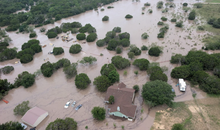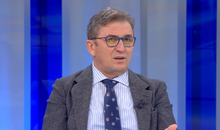
 Flash News
Flash News
International drug search: 36-year-old arrested in Durrës (NAME)
Veliaj's appeal to be heard today in the High Court
Today's hearing at the Fier Court, Salianji requests conditional release
Taxi collides with truck on Lezhë-Shkodër axis, driver taken to Trauma in serious condition
At least 91 dead in Texas floods
WB: in 2025, weakening demand and investment increases uncertainties

Albania closed 2024 with an economic growth of 3.9%, maintaining a stable pace for the second consecutive year, according to the World Bank's Spring 2025 Economic Report.
Growth has been supported by private consumption, remittances, and the expansion of lending to households.
However, the outlook for 2025 is bleaker. Economic growth in Albania is expected to slow to 3.2%, and to 3.1% in 2026, due to slowing external demand, weakening foreign investment, and global uncertainties related to geopolitical tensions and trade policies.
At the regional level, the Western Balkans has maintained an average growth of 3.5% in 2024, with Kosovo and Serbia recording among the highest increases.
For 2025, the report predicts an overall slowdown in the region, with average growth expected to fall to 3.2%.
Kosovo remains among the countries with the most optimistic projection at 3.8%, followed by Serbia at 3.5% and Albania at 3.2%. Meanwhile, Montenegro and Bosnia are expected to remain at moderate levels, at 3.0% and 2.7%, respectively.
The forecasts reflect the impact of weak external demand, geopolitical tensions, and a more difficult financial environment for investment across the region.
The region remains influenced by the performance of the European economy and exposure to foreign markets, while consumption and remittances continue to be the main growth engines.
World Bank experts recommend deepening reforms to improve the business climate, foster innovation, and reduce dependence on state-owned enterprises to support more sustainable, private-sector-led growth.
Slower growth threatens Eastern Europe as urgency for reform grows
Slower growth is weighing on Eastern Europe and Central Asia, as inflation, weak external demand and structural inertia take hold. The World Bank is calling for bold reforms to unleash productivity and avoid the middle-income trap.
Robust consumption helped keep the emerging economies of Europe and Central Asia afloat last year, but a toxic mix of weak external demand, persistent inflation and structural weaknesses is now threatening to plunge the region into a low-growth trap.
According to the World Bank's Spring 2025 Economic Report, released on Wednesday, regional growth is expected to slow to an average of just 2.5% for 2025 and 2026.
If Russia is excluded from these data, the forecast improves somewhat to 3.3%, but remains significantly below the 4% average for the 2010–2019 period.
Which countries are slowing down and why?
World Bank data shows that Central Asia, ECA's fastest-growing subregion, is not immune.
Its growth is expected to slow from strong levels in 2024 to 4.7% for 2025–2026, impacted by lower expansion of Kazakhstan's oil sector, declining exports, and slowing remittance flows.
Russia faces a sharp downturn, with growth projected at just 1.3% — nearly three times slower than in 2024. Stronger sanctions, rising borrowing costs, and lower energy prices are adding to structural constraints, risking its economy drifting off its pre-pandemic path.
Turkey, which is undergoing a delicate economic rebalancing, is expected to expand by 3.3%, a notable improvement compared to recent years, but still below its long-term average.
Poland has a more optimistic outlook, with growth of 3.1%, supported by investments supported by European Union funds, however it still remains below its pre-2020 average due to eurozone weakness and ongoing trade policy risks.
In the Western Balkans and the South Caucasus, growth is expected to moderate to 3.4% and 3.5%, respectively, while Ukraine's recovery is likely to slow significantly, with growth projected at 2% due to ongoing war-related challenges.
Without urgent reforms, the risk is stagnation. The World Bank warns that countries that fail to modernize their economic frameworks, broaden their tax base, and invest in human capital may struggle to sustain even modest growth.
For many countries, fiscal space is shrinking, limiting opportunities for stimulus, while public spending needs are increasing.
To avoid stagnation and move closer to high-income status, the region must advance business innovation, create competitive markets, and implement productivity-enhancing reforms. Without these, the promise of convergence with more advanced economies risks slipping further out of reach./ Monitor
Latest news


Fire in Dukat endangers Llogara National Park
2025-07-08 10:01:39
International drug search: 36-year-old arrested in Durrës (NAME)
2025-07-08 09:50:48
Thethi, tourists "criticize" modern trend
2025-07-08 09:39:54
Fire on Mount Dukat still active, Llogara National Park at risk
2025-07-08 09:28:12
Veliaj's appeal to be heard today in the High Court
2025-07-08 09:16:02
"Bad sign for democracy"/ Parliament neglects reporting by institutions
2025-07-08 09:04:56
Today's hearing at the Fier Court, Salianji requests conditional release
2025-07-08 08:56:39


Horoscope, what do the stars have in store for you today?
2025-07-08 08:16:19
Weather forecast/ How temperatures will vary throughout the day
2025-07-08 08:02:37
Morning Post/ In 2 lines: What mattered yesterday in Albania
2025-07-08 07:48:30





Marrëdhënia që s’është romancë, por s’është as thjesht kolegiale
2025-07-07 21:39:13
Citizen is asked to pay 2.5 million for a non-existent meter
2025-07-07 21:28:03




What is the ideal air conditioner temperature in summer?
2025-07-07 20:53:46
GJKKO left him in prison, Meta appeals the decision
2025-07-07 20:38:05
Where is Ronaldo after missing Diogo Jota's funeral?
2025-07-07 20:38:04

Messages from the author who killed Ilaria Sulla in Rome are revealed
2025-07-07 20:20:12
At least 91 dead in Texas floods
2025-07-07 20:12:02
Elbasan, choked by smoke, scorched by conscience
2025-07-07 19:48:16

Swarm of bees attacks citizens in France, 24 people end up in hospital
2025-07-07 19:32:03
Dementia/Hearing loss may be a warning sign
2025-07-07 19:13:06
The decision for Malltez, Gjokutaj: Boomerang for SPAK and the Court
2025-07-07 19:01:08

Former Supreme Court member acquitted of asset concealment
2025-07-07 18:36:40

WIIW expert in Politiko: Brain drain is steadily weakening the Albanian economy
2025-07-07 18:11:41
Heart health is at risk from extreme heat, here's what you should be careful of
2025-07-07 18:10:18
Today Gert Bogdani would celebrate, Edlira Çepani's touching dedication
2025-07-07 17:40:45






The striker severely accuses the Fenerbahce club: They tried to drug me
2025-07-07 16:21:03
A decomposed body is found in Kolonjë, initial suspicions
2025-07-07 16:03:31
Accident in Saranda, car hits motorcycle, one injured
2025-07-07 15:58:56

The most fertile age for men and women
2025-07-07 15:40:52
Locals, Rama candidate in 5 municipalities
2025-07-07 15:32:22
Blushi: Meta's criminal kidnapping, incomparable even to Navalny's in Russia
2025-07-07 15:20:34
Meet the iPhone 17 Pro, the main innovations in design and technology
2025-07-07 15:09:09
Why the release of Abi Malltez does not free him; much less Albania
2025-07-07 15:00:12
‘Lidhjet klienteliste’ të mjekëve mbushin recetat e pacientëve
2025-07-07 14:57:33
Poland imposes border controls with Germany and Lithuania
2025-07-07 14:48:15

Caught transporting firearms from Kosovo to Albania, young man arrested (NAME)
2025-07-07 14:37:47
Theo Hernandez flies to Saudi Arabia for medical check-ups
2025-07-07 14:26:47


Scorching heat, Greece orders mandatory work holidays
2025-07-07 13:54:25




Trump expects Netanyahu to discuss Gaza ceasefire
2025-07-07 12:54:27

GJKKO releases Jamarbër Malltezi from house arrest
2025-07-07 12:35:02
Tourism among contrasts
2025-07-07 12:31:01
IKMT action in Theth, starts demolition of unauthorized constructions
2025-07-07 12:24:18

The Tirana-Kamëz line is destroyed by urban fire
2025-07-07 12:00:24




Poor direction!
2025-07-07 11:16:01


Rama to gather the country's mayors on July 9
2025-07-07 10:43:31

Ohrid Natural Park on the way to UNESCO's "black list"
2025-07-07 10:25:58

Registrations for the new school year begin in e-Albania
2025-07-07 09:59:09
KAS decides the "fate" of the elections in four districts of the country today
2025-07-07 09:50:51
Rama does not give up on Vlora, visits the municipality again
2025-07-07 09:39:11


Fires in Gjirokastra, flames very close to cultural monuments
2025-07-07 09:12:49

Foreign exchange, the rate at which foreign currencies are sold and bought
2025-07-07 08:39:57

Horoscope, what do the stars have in store for you today?
2025-07-07 08:14:17
The week starts with scorching temperatures, the thermometer reaches 37°C
2025-07-07 07:58:36
Morning Post/ In 2 lines: What mattered yesterday in Albania
2025-07-07 07:45:15

